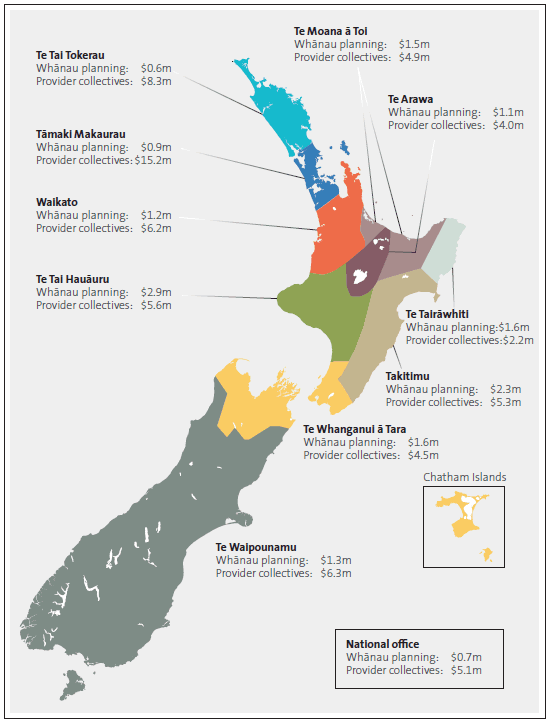Part 5: Overview of spending
5.1
In this Part, we report on:
- how funding for the Initiatives was divided;
- how much funding was spent on the Initiatives; and
- where funding went throughout the country.
How was funding for the Initiatives divided?
5.2
In 2009/10, Te Puni Kōkiri used a relatively small amount of funding to get the Initiatives up and running. The Government made $1.1 million of administration funding available, and $1.0 million was spent.
5.3
The Government announced funding for the Initiatives in Budget 2010. In the public service, a "fund" is called an output class or appropriation. At first, three output classes were announced:
- The WIIE fund made funds available to whānau through some form of legal entity to enable them to prepare plans to improve their lives.
- The Service Delivery Capability fund made funds available to providers, who used it to build their capability to deliver whānau-centred services.
- The Whānau Ora Administration fund covered the costs of promoting and carrying out the Initiatives, including research and evaluation.
5.4
In 2013/14, three more output classes were added to get the commissioning agencies up and running. Figure 4 shows the output classes for the first four years of the Initiatives and, where relevant, their end dates.
Figure 4
How funding for the Initiatives was divided, from 2010/11
| Funding available for service providers, whānau, and commissioning agencies | Period | |
| Whānau ora-based service development | Whānau Integration, Innovation, and Engagement (to support providers to develop whānau integration, innovation, and engagement) | From 2010/11 to 2013/14 |
| Service Delivery Capability (to support providers to develop whānau ora service delivery capability) | From 2010/11 to 2015/16 | |
| Commissioning agencies | Commissioning Whānau Ora Outcomes (to fund the commissioning agencies) | From 2013/14 |
| Establishment of a Whānau Ora Commissioning Approach (to help pay for commissioning agencies' once-only establishment costs) | From 2013/14 | |
| Funding for Te Puni Kōkiri's use | Period | |
| Administration | Whānau Ora Administration (to implement, develop, and evaluate the whānau ora service delivery approach) | From 2009/10 |
| Whānau Ora Commissioning Administration (to implement, develop, and evaluate the whānau ora commissioning approach) | From 2013/14 | |
Source: Te Puni Kōkiri's annual reports, www.tpk.govt.nz.
Note: The definitions of "provider" for the Service Delivery Capability fund and the WIIE fund are not the same.
5.5
From 2010/11 to 2013/14, the Government's original budgets set out plans for Whānau Ora spending for each output class. Each year's original budget was updated during the year to reflect the speed of implementation. Because progress was slower than expected, funds were transferred from one year to future years and money was transferred between the WIIE fund and Service Delivery Capability fund.
5.6
Funding from 2011/12 and 2013/14 (adding up to $16.3 million) that had not yet been committed under the WIIE fund and the Service Delivery Capability fund was "reprioritised" for the commissioning agencies from 2013/14.
Total spending
5.7
The total amount spent was $137.6 million, which was made up of:
- $20.8 million (15% of the total) spent through the WIIE fund;
- $67.9 million (49% of the total) spent through the Service Delivery Capability fund;
- $6.6 million (5% of the total) spent through the funds for commissioning agencies; and
- $42.3 million (31% of the total) spent on administration (including research and evaluation).
5.8
An extra $10 million has been transferred to Vote Health to pay for a Whānau Ora information system (see Part 8).
Where funds went throughout the country
5.9
Figure 5 shows the total payments made in each of Te Puni Kōkiri's regions and by Te Puni Kōkiri's national office in Wellington. It shows that some whānau in each region applied for, and were successful in getting, funding through Whānau Ora, and that each region had one or more provider collectives.
Figure 5
Total payments made to whānau and provider collectives in each of Te Puni Kōkiri's regions, 2010/11 to 2013/14

Notes: Some whānau members might not live in the Te Puni Kōkiri region that funded their whānau plan. Te Puni Kōkiri's national office managed the WIIE fund in 2010/11. The regions managed the WIIE fund from 2011/12 to 2013/14. Both funds paid for navigators, but most were funded through the Service Delivery Capability fund.
Our observations
5.10
There were significant transfers between years and adjustments within financial years, which is administratively cumbersome and, in our experience, unusual. Cumulatively, delays in spending the available budgets meant that some of the funds intended for whānau and providers did not reach them as originally planned. In our view, better planning and financial management were needed.

